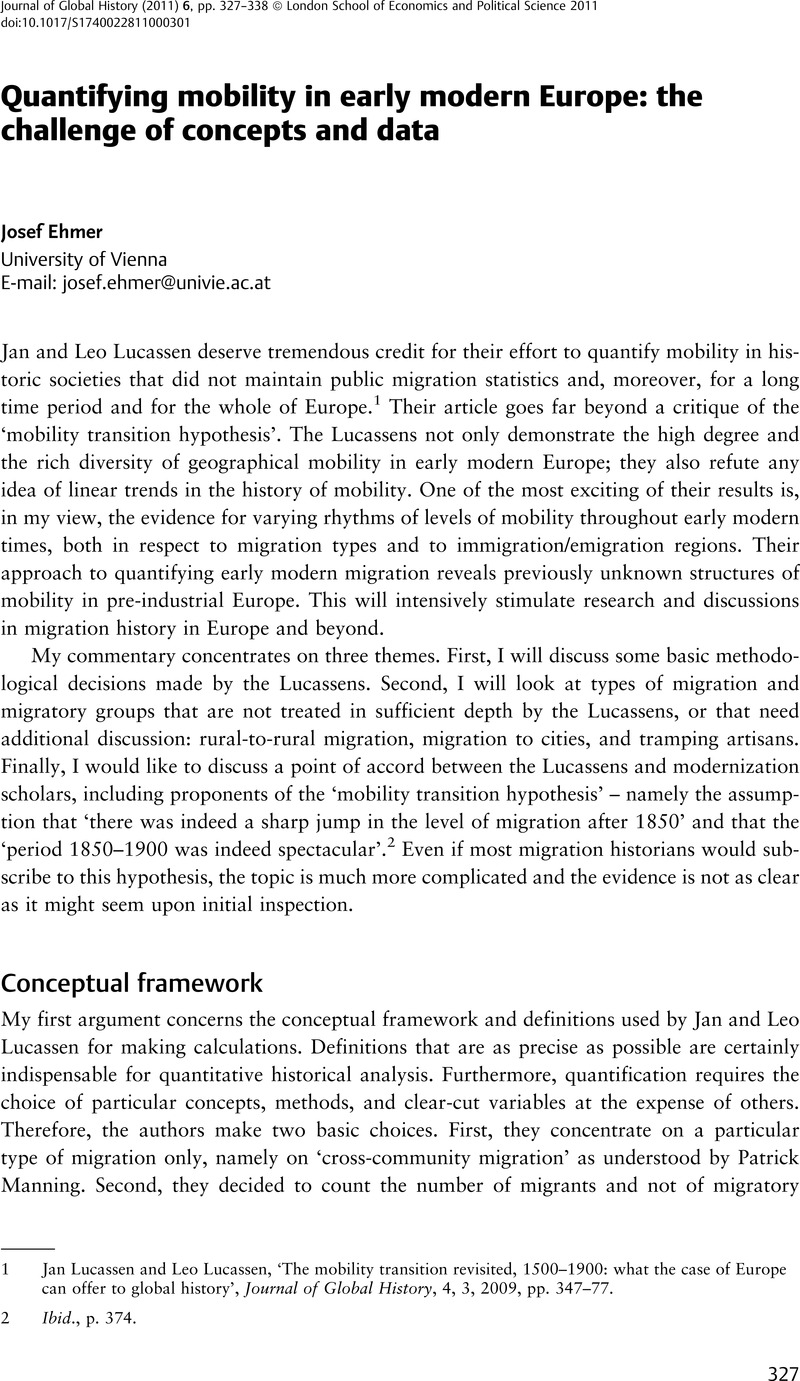Article contents
Quantifying mobility in early modern Europe: the challenge of concepts and data
Published online by Cambridge University Press: 13 June 2011
Abstract

Information
- Type
- Articles
- Information
- Copyright
- Copyright © Cambridge University Press 2011
References
1 Jan Lucassen and Leo Lucassen, ‘The mobility transition revisited, 1500–1900: what the case of Europe can offer to global history’, Journal of Global History, 4, 3, 2009, pp. 347–77.
2 Ibid., p. 374.
3 Hartmut Kaelble, ‘Einführung und Auswertung’, in Conze, Werner and Engelhardt, Ulrich, eds., Arbeiter im Industrialisierungsprozess, Stuttgart: Klett-Cotta, 1979, p. 19Google Scholar.
4 Köllmann, Wolfgang, Bevölkerung in der industriellen Revolution, Göttingen: Vandenhoeck und Ruprecht, 1974, pp. 41, 48Google Scholar; idem, Bevölkerung und Raum in Neuerer und Neuester Zeit, Würzburg: Ploetz, 1965, pp. 65ff.
5 Patrick Manning, ‘Concepts and institutions for world history: the next ten years’, in Manning, Patrick, ed., World history: global and local interactions, Princeton, NJ: Princeton University Press, 2005, p. 240Google Scholar. See also idem, Migration in world history, London: Routledge 2005, pp. 3–10.
6 Patrick Manning, ‘Cross-community migration: a distinctive human pattern’, Social Evolution & History, 5, 2, 2006, pp. 34–5.
7 The significance of topics such as migration systems, diasporas, and returning migrants is acknowledged in Patrick Manning’s approach; see Patrick Manning, ‘Introduction: current research topics in world history’, in Manning, World history, p. 10.
8 This is shown very clearly by the biographical approach of Pooley, Colin G. and Turnbull, Jean, Migration and mobility in Britain since the eighteenth century, London: UCL Press, 1998, p. 65Google Scholar.
9 Lucassen and Lucassen, ‘Mobility transition’, p. 353.
10 As a convincing example, see the reconstruction of German migration rates from 1820 to 1989 in Hochstadt, Steve, Mobility and modernity: migration in Germany, 1820–1989, Ann Arbor, MI: University of Michigan Press, 1999CrossRefGoogle Scholar.
11 See Lucassen, Jan, Migrant labour in Europe: the drift to the North Sea, London: Croom Helm, 1987Google Scholar; Lourens, Piet and Lucassen, Jan, Arbeitswanderung und berufliche Spezialisierung: die lippischen Ziegler im 18. und 19. Jahrhundert, Osnabrück: Rasch, 1999Google Scholar; Leo Lucassen, ‘A blind spot: migratory and travelling groups in Western historiography’, International Review of Social History, 38, 1993, pp. 209–35.
12 Lucassen and Lucassen, ‘Mobility transition’, pp. 351, 363–4.
13 Braudel, Fernand, The Mediterranean and the Mediterranean world in the age of Philip II, Berkeley, CA: University of California Press, 1996, vol. 1, pp. 85–102Google Scholar; Jean-Claude Duclos, ‘La transhumance, modèle de complémentarité entre la montagne et la plaine’, Histoire des Alpes/Storia delle Alpi/Geschichte der Alpen, 3, 1998, pp. 179–87.
14 As for Tuscany, see Massaini, Moreno, Transumanza dal Casentino alla Maremma: storie di uomini ed armenti lungo le antiche dogane, Roma: Aldo Sara Editore, 2005Google Scholar.
15 Braudel, Mediterranean, p. 91.
16 Ibid.
17 Duclos, ‘Transhumance’, p. 183.
18 Michael Mitterauer, ‘Formen ländlicher Familienwirtschaft: historische Ökotypen und familiale Arbeitsorganisation im österreichischen Raum’, in Ehmer, Josef and Mitterauer, Michael, eds., Familienstruktur und Arbeitsorganisation in ländlichen Gesellschaften, Vienna: Böhlau Verlag, 1986, pp. 194, 282, 308–11Google Scholar.
19 Rosental, Paul-André, Les sentiers invisibles: espace, familles et migrations dans la France du 19e siècle, Paris: ESSHS, 1999Google Scholar.
20 Hochstadt, Mobility and modernity.
21 These growth rates are based on the registration of immigrants and emigrants by local government officials. I discuss the problems associated with this type of source material below.
22 Pooley and Turnbull, Migration and mobility, pp. 306–8.
23 Stefan Bleek, ‘Mobilität und Sesshaftgkeit in deutschen Großstädten während der Urbanisierung’, Geschichte und Gesellschaft 15, 1989, pp. 5–33.
24 Hochstadt, Mobility and modernity, pp.137ff.
25 See Jackson, J. H., Migration and urbanization in the Ruhr valley 1821–1914, Atlantic Highlands, NJ: Humanities Press, 1999Google Scholar.
26 This is more fully discussed in my article ‘Lohnarbeit und Lebenszyklus im Kaiserreich’, Geschichte und Gesellschaft, 14, 1988, pp. 448–71.
27 Pooley and Turnbull, Migration and mobility, p. 307.
28 Lucassen and Lucassen, ‘Mobility transition’, p. 364.
29 Leiner, Stefan, Migration und Urbanisierung: Binnenwanderungsbewegungen, räumlicher und sozialer Wandel in den Industriestädten des Saar-Lor-Lux-Raumes 1856–1910, Saarbrücken: Saarbrücker Druckerei und Verlag, 1994Google Scholar.
30 Hochstadt, Mobility and modernity.
31 This topic is discussed more fully in my ‘Journeymen’s migration as nineteenth-century mass migration’, in Leboutte, René, ed., Migrations et migrants dans une perspective historique: permanences et innovations/Migrations and migrants in historical perspective: permanencies and innovations, Brussels: P.I.E.-Peter Lang, 2000, pp. 97–109Google Scholar.
32 Hochstadt, Mobility and modernity, pp. 50–1.
33 Ibid.
34 Ibid., p. 277.
35 Lucassen and Lucassen, ‘Mobility transition’, p. 81.
36 Reinhold Reith, ‘Gesellenwanderung’, in Enzyklopädie der Neuzeit, vol. 4, Stuttgart: J. B. Metzler, 2006.
37 See Deter, Gerhard, Handwerk vor dem Untergang? Das westfälische Kleingewerbe im Spiegel der preussischen Gewerbetabellen 1816–1861, Stuttgart: Steiner, 2005Google Scholar.
38 Leiner, Migration, p. 48; see also Ernst Hoffmann, Das Meldewesen der Stadt Chemnitz im Kapitalismus, Karl-Marx-Stadt: Stadtarchiv, 1980.
39 For a detailed analysis of such sources, see Steidl, Annemarie, Auf nach Wien! Die Mobilität des mitteleuropäischen Handwerks im 18. und 19. Jahrhundert am Bespiel der Haupt- und Residenzstadt, Wien: Verlag für Geschichte und Politik, 2003Google Scholar.
40 In German-language historiography, see especially Köllmann, Bevölkerung in der industriellen Revolution and Köllmann, Bevölkerung und Raum. For a full discussion, see my ‘Migration and population in German historical thought: some critical reflections’, in Bommes, Michael and Morawska, Ewa, eds., International migration research: constructions, omissions and the promises of interdisciplinarity, Ashgate: Aldershot, 2005, pp. 19–40Google Scholar.
41 An excellent example in respect to tramping journeymen is Wadauer, Sigrid, Die Tour der Gesellen: Mobilität und Biographie im Handwerk vom 18. bis zum 20. Jahrhundert, Frankfurt-am-Main: Campus Verlag, 2005Google Scholar.
- 3
- Cited by

